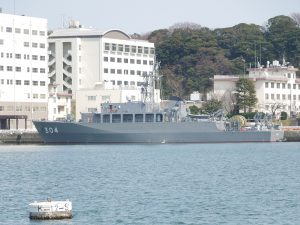Last week, a new minesweeper — the third in the Awaji-class — was launched by Japan Marine United Corporation, Jane’s Defense Weekly reported last week.
JS Etajima, a mine countermeasures vessel, was formally named and launched in a ceremony at Yokohama shipyard, Japan Marine United Corporation (JMUC), the shipbuilding firm in charge of manufacturing the vessel, said. The ceremony took place on December 12.
Mine countermeasures vessels are used to locate, clear, and destroy naval mines, which can impede shipping and naval operations.
Etajima is the third vessel of the Awaji class of minesweepers built for the Japan Maritime Self-Defense Force (JMSDF) by JMUC.
The Japanese government requested approximately $118 million for the 2020 fiscal year to go toward the construction of a fourth vessel in the Awaji class of minesweepers.
Awaji-class minesweepers like the Etajima are equipped with advanced all-weather sensor systems and are capable of conducting operations during day and night. Crewed by some 55 sailors, the Awaji class displaces 690 tonnes.
Physically, the vessel is 67 meters long, with a beam measurement of 11 meters. The vessel’s draft is 5.2 meters and it can sail at a top speed of 14 knots. The vessel uses fiber reinforced plastic for its hull to drastically reduce its weight and overall magnetic signature.
Etajima is named for an island in Japan’s Hiroshima prefecture. The JMSDF is expected to take formal delivery of the Etajima in March 2021, according to Naval News.
The lead ship of the class, JS Awaji, was launched in October 2015 and delivered in March 2017. A second vessel, JS Hirado, was launched in February 2017.
The Awaji-class minesweepers succeed the JMSDF’s older Yaeyama-class minesweepers, the last of which was decommissioned in June 2017.
The JMSDF operated the Yaeyama class beginning in the early 1990s. Six vessels were originally planned in the Yaeyama class, but just three were completed and delivered to the JMSDF.
The Yaeyama class is physically similar in dimensions to the Awaji class, but is much heavier, at a displacement of 1,000 tons. The Yaeyama-class vessels did not use fiber reinforced plastic, but wood as a primary hull material.
The three vessels of the Yaeyama class included JS Yaeyama, JS Tsushima, and JS Hachijyo.
During the first Gulf War, Japan dispatched minesweepers to the Persian Gulf. Six vessels “were dispatched in order to remove and dispose of sea mines in the Persian Gulf in order to ensure the safe passage of Japanese ships,” according to the Japanese Ministry of Defense.

































